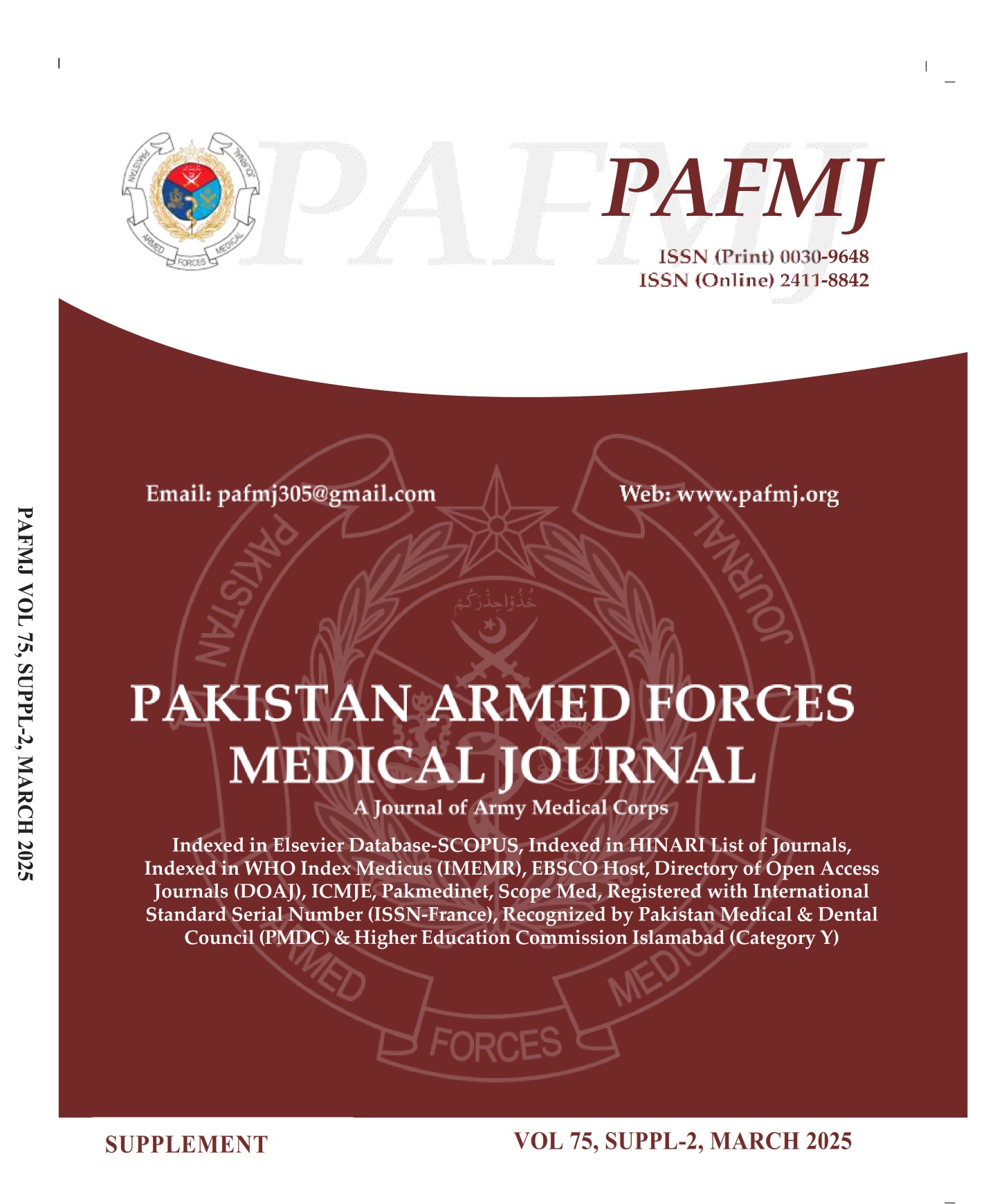Pattern of Transfusion Related Zinc and Copper Derangements in Beta Thalassemia Major Patients
DOI:
https://doi.org/10.51253/pafmj.v75iSUPPL-2.8554Keywords:
Atomic Absorption Spectrophotometry, Beta Thalassemia Major, Serum Zinc, Serum CopperAbstract
Objective: To assess serum zinc and copper levels in beta thalassemia major patients as compared to healthy subjects.
Study Design: Comparative cross-sectional study.
Place and Duration of Study: Chemical Pathology and Endocrinology Department Armed Forces Institute of Pathology, in collaboration with Armed Forces Institute of Transfusion, Rawalpindi Pakistan, from Jan 2021 to Jun 2021.
Methodology: The patients of transfusion dependent thalassemia major aged between 4 to 35 years were included in the study along with healthy subjects in 1:1. After collection of blood samples in plain serum tubes, serum Zinc (Zn) and copper (Cu) levels of all subjects were analyzed on atomic absorption spectrophotometer. Zn and Cu levels were expressed as Mean±SD. Independent sample t-test with significant p-value of ≤0.005 was used to compare Zn and Cu concentration of patients with thalassemia major with that of healthy controls.
Results: Study included 80 subjects (40 patients and 40 controls) with mean age of 13.33±7.69 years. The mean value of serum Zn and Cu in beta thalassemia major patients were 8.62±1.77 µmol/L and 14.46±5.92µmol/L respectively as compared to 15.08±2.8 µmol/L and 13.45±2.80 µmol/L in healthy controls. Zn levels showed a statistically significant difference (p=0.005) between two groups while Cu levels also showed statistically significant difference (p=0.03) between the two groups.
Conclusion: Beta thalassemia major patients showed significantly lower levels of serum zinc and higher levels of serum copper as compared to healthy controls which should be taken into consideration for continuous monitoring and prompt correction.
Downloads
References
Muncie Jr HL, Campbell JS. Alpha and beta thalassemia. Am Family physician 2009; 80(4): 339-344.
Eleftheriou A. About thalassemia. Thalassemia Int Pub 2003; 2: 11-2.
Ansari SH and Shamsi TS. Thalassaemia prevention programme. Hematol Updates 2010: 23-28.
Khalid N, Noreen K, Qureshi FM, Mahesar M. Knowledge of thalassemia and consanguinity: A multicenter hospital based retrospective cohort study from metropolitan city of Karachi, Pakistan. Professional Med J 2019; 26(09): 1580-6.
https://doi.org/10.29309/TPMJ/2019.26.09.168
Fung EB. Nutritional deficiencies in patients with thalassemia. Ann N Y Acad Sci 2010; 1202: 188–196.
https://doi.org/10.1111/j.1749-6632.2010.05578.x
Borgna-Pignatti C. Modern treatment of thalassaemia intermedia. Br J Haematol 2007; 138: 291–304.
https://doi.org/10.1111/j.1365-2141.2007.06654.x
Şahin A, Er Oe, Öz E, Yıldırmak ZY, Bakırdere S. Sodium, magnesium, calcium, manganese, iron, copper, and zinc in serums of beta thalassemia major patients. Biol Trace Elem Res 2021; 199(3): 888–894.
https://doi.org/10.1007/s12011-020-02217-5
Ahyar A. The preventive role of zinc from communicable and non-communicable diseases in children. NCD Malaysia 2005; 4: 21–26.
Marengo-Rowe AJ. The thalassemias and related disorders. Proc (Bayl Univ Med Cent) 2007; 20: 27–31.
https://doi.org/10.1080/08998280.2007.11928230
Shamshirsaz AA., Bekheirnia MR, Kamgar M, Pourzahedgilani N, Bouzari N, Habibzadeh M, et al. Metabolic and endocrinologic complications in beta-thalassemia major: A multicenter study in Tehran. BMC Endocr Disord 2003; 3(1): 4.
https://doi.org/10.1186/1472-6823-3-4
Fraga CG. Review relevance, essentiality and toxicity of trace elements in human health. Mol Aspects Med 2005; 26: 235–244.
https://doi.org/10.1016/j.mam.2005.07.013
Ansari SH, Shamsi TS, Ashraf M,. Molecular epidemiology of β-thalassemia in Pakistan: far reaching implications. Int J Mol Epidemiol Genetics 2011; 2: 403.
Rea IM, Rea M. Department of Geriatric Medicine The Queen's University of Belfast, UK Accepted 16 June 1988, Available online 26 May 2006.
Nimkarn N, Songdej D, Dumrongwongsiri O, Sirachainan N, Chuansumrit A, Age as a major factor associated with zinc and copper deficiencies in pediatric thalassemia, JTrace ElemMed and Bio 2021; 68: 126817.
https://doi.org/10.1016/j.jtemb.2021.126817
Matter RM, Elbarbary NS, Ismail EA, Darwish YW, Nada AS, Banoub VP, et al. Zinc supplementation improves glucose homeostasis in patients with β-thalassemia major complicated with diabetes mellitus: A randomized controlled trial. Nutrition 2020; 73: 110702. https://doi.org/10.1016/j.nut.2019.110702
Sharif Y, Irshad S, Tariq MH, Qadeer MI, Sharif S. Correlation of serum trace elements (copper and selenium) in patients with beta thalassemia major in Pakistan. Trace Elements and Electrolytes 2020; 37(1): 17- 22.
https://doi.org/10.5414/TEX01595
Eman M. Fahmya, Eman H. Salamab , Nesreen A. Mohammedc Departments of, a Pediatric, b Clinical Pathology, Public Heath and Community Medicine, Sohag University Hospital, Sohag, Egypt
Zekavat, Omid R. MD*; Bahmanjahromi, Ayda MD†; Haghpanah, Sezaneh MD, MPH*; Ebrahimi, Sara MSc‡; Cohan, Nader PhD* The Zinc and Copper Levels in Thalassemia Major Patients, Receiving Iron Chelation Therapy. J Pediatr Hematol Oncol 2018; 40(3): 178-81.
https://doi.org/10.1097/MPH.0000000000001102
Bashir NA. Serum zinc and copper levels in sickle cell anaemia and β-thalassaemia in North Jordan. Ann Trop Paediatr 1995; 15: 291-293. https://doi.org/10.1080/02724936.1995.11747786
Kajanachumpol S, Tatu T, Sasanakul W, Chuansumrit A, Hathirat P. Zinc and copper status of thalassemic children. Southeast Asian J Trop Med Public Health 1997; 28: 877-880
Downloads
Published
Issue
Section
License
Copyright (c) 2025 Kehkshan Waheed, Zujaja Hina Haroon, Afshan Bibi, Muhammad Usman Munir, Sobia Irum Kirmani, Muhammad Amir

This work is licensed under a Creative Commons Attribution-NonCommercial 4.0 International License.















